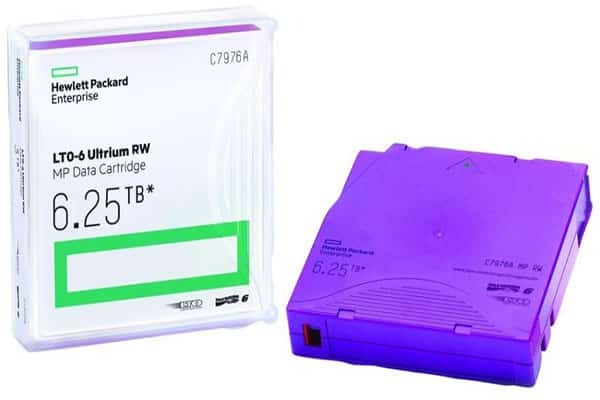A magnetic tape storage medium produced by Hewlett-Packard (HP) is called an HP data cartridge. It is used by organisations to back up their archives, store them over time, and also as a means of disaster recovery. It has much higher storage capacity and longevity compared to most other backup media.
Purpose and Use Cases
An HP data cartridge is used where large volumes of data are required to be stored. Typical use cases include:
- Long-term archival of business data.
- Database, file systems, or email system backup.
- Disaster recovery planning.
- Offsite rotation of backup sets.
- Adherence to data retention laws.
Tape is not as susceptible to some internet-based threats (e.g., ransomware) due to its offline and removable nature.
How It Works: Basic Principles
An HP data cartridge is a closed tape cassette filled with magnetically coated tape wound around reels. When inserted into a compatible tape drive, the drive head comes in contact with the tape to write or read data. The tape passes through the playback/write devices at a constant pace. The information is stored in tracks. Other functions, such as error correction and verification, are also performed during writing by the drive.
Key Features of HP Data Cartridges
The following are the key features that make HP data cartridges convenient:
| Feature | Description |
|---|---|
| High Capacity | A current cartridge has terabytes of uncompressed capacity. |
| Durability | The tapes have a rating of many years of archival life (20+ years when it is under the right conditions). |
| Reliability | In-built error recovery and reduced bit error rates. |
| Removable Medium | Cartridge rotating or off-site transporting is possible. |
| Low Power Consumption | When no tape, no energy is consumed. |
| Cost Efficiency | It is cheaper in terms of cost per gigabyte than certain disk or flash media. |
Generations and Formats
HP cartridges come in various varieties and generations. Some common ones include:
- LTO (Linear Tape-Open): An industry standard used by HP and other manufacturers.
- HP proprietary formats: Used in the past for older systems.
LTO cartridges are upgraded generationally (LTO-5, LTO-6, LTO-7, etc.). Newer generations are usually more capable and faster.
Backward compatibility is limited: drives typically read one or two earlier generations; however, they cannot write to older formats.
Compatibility and Requirements
An HP data cartridge will not work with a tape drive other than those compatible with that cartridge. Factors to check include:
- Format generation (e.g., LTO-6 drive and LTO-6 cartridge).
- Read/write compatibility (some drives are read-only for prior generations).
- Interface (SCSI, SAS, Fibre Channel).
- Support for automation (e.g., robotic libraries).
Using the wrong drive or format may lead to damage to the tape or drive.
Advantages of HP Data Cartridges
- Longevity: With magnetic tape, it is possible to store data reliably for decades.
- Scalability: Storage can be easily expanded by simply adding cartridges.
- Energy Efficiency: Tapes do not consume power when idle.
- Offline Protection: Protects against network attacks and data corruption when offline.
- Cost-Effective: For large volumes, tape is frequently more affordable than disk.
Limitations and Challenges
- Access Speed: Seek and load times of tapes are longer than those of disks.
- Sequential Access: Reading and writing are slower; sometimes a tape needs to be fully wound.
- Management Complexity: Requires tracking, rotation, and validation.
- Environmental Sensitivity: Tape can be damaged by humidity, temperature, and magnetic fields.
- Format Obsolescence: Drive discontinuation may make older or proprietary formats unreadable.
Best Practices for Usage
HP data cartridges should be used according to the following guidelines for best results:
- Store cartridges in a cool, dry, and stable environment.
- Do not expose them to direct sunlight, humidity, or magnetic sources.
- Periodically read or rewrite data to maintain integrity.
- Label cartridges clearly and maintain a catalogue.
- Rotate tapes (daily, weekly, or monthly) to avoid wear.
- Check for and verify errors regularly.
- Keep spare cartridges for emergency recovery.
Conclusion
The HP data cartridge is a sturdy magnetic tape medium that offers the ability to back up and store large volumes of data. It uses a tape drive that reads and writes data in linear tracks. Its top strengths are capacity, durability, and cost-effectiveness. However, it also has limitations in speed, accessibility, and format dependency.
In the hands of an attentive and well-disciplined user, an HP data cartridge can still serve as an important part of business backup programs.
